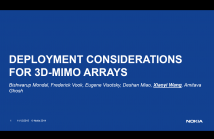
The IEEE Global Conference on Signal and Information Processing (GlobalSIP) is a flagship conference of the IEEE Signal Processing Society. GlobalSIP'15 will be held in Orlando, Florida, USA, December 14-16, 2015. The conference will focus on signal and information processing with an emphasis on up-and-coming signal processing themes. The conference will feature world-class speakers, tutorials, exhibits, and sessions consisting of poster or oral presentations. Outstanding papers will be selected for Best Paper Awards or Best Student Paper Awards; a paper is eligible for a best student paper award if the first author of the paper is a student. IEEE Signal Processing Society and National Science Foundation will provide travel grants to eligible students.
- Read more about Subject Independent Affective States Classification Using EEG Signals
- Log in to post comments
Affective states classification has become an important part of the Human-Computer Interface (HCI) study. In recent years, studies of physiological signals, such as ECG, GSR and EEG on affective expression have shown very promising results. In this study, we carried out two experiments to better understand the neurological expression of emotions through the use of EEG signals. In particular, we carried out a subject- independent affective states classification study using narrow- band spectral power of the EEG signals.
- Categories:
 16 Views
16 Views- Read more about Frequency Estimation for a Mixture of Sinusoids: A Near-Optimal Sequential Approach
- Log in to post comments
An extended version of the paper has been submitted to IEEE Transactions on Signal Processing (TSP):
B. Mamandipoor, D. Ramasamy, U. Madhow, “Newtonized Orthogonal Matching Pursuit: Frequency Estimation over the Continuum,”arXiv preprint arXiv:1509.01942, 2015.
A MATLAB implementation of the algorithm can be found here:
https://bitbucket.org/wcslspectralestimation/continuous-frequency-estima...
- Categories:
 32 Views
32 Views- Read more about Control Mechanism Modeling of Human Cardiovascular-Respiratory System
- Log in to post comments
GSIP_Gutta.pdf
- Categories:
 21 Views
21 Views- Read more about Placing and Sizing Distributed Photovoltaic Generators for Optimal Reactive Power Compensation
- Log in to post comments
A two-stage stochastic programming approach is pursued to optimally place and size photovoltaic (PV) inverters in a radial distribution network under solar irradiance and load uncertainties. First-stage variables include binary PV unit placement as well as continuous real and apparent power capacities of the inverters. Second-stage decisions comprise reactive power compensation, power flows, and nodal voltages, which are determined adaptively to the uncertainty. The objective is to minimize installation cost and expected thermal losses on the network.
- Categories:
 21 Views
21 Views
- Read more about DEPLOYMENT CONSIDERATIONS FOR 3D-MIMO ARRAYS
- Log in to post comments
- Categories:
 9 Views
9 Views- Read more about An Efficient GPU Implementation of a Multirate Resampler for Multi-carrier Systems
- Log in to post comments
In modern communication systems, a sample rate
conversion is necessary since often the system clock is fixed at
some specific rate. Such resampling is critical because there exists
a tight coupling between the data rates and sampling rates. It
is desirable to have a flexible, high performance, and resource
efficient resampler that can accommodate various required data
rates. To achieve these objectives, we present a novel multirate
resampling method based on graphics processing units (GPUs).
- Categories:
 25 Views
25 Views- Read more about Differential Beamspace MIMO for High-Dimensional Multiuser Communication
- Log in to post comments
We develop a new multiple input multiple output (MIMO) transceiver architecture – Differential Beamspace MIMO (DB-MIMO) for high-dimensional MIMO systems. DB- MIMO enables linear quasi-coherent interference suppression between multiple spatially multiplexed data streams in con- junction with differential transmission. The differential nature of DB-MIMO is particularly attractive in emerging high- frequency systems, e.g. centimeter-wave (cmW) and millimeter- wave (mmW) systems, where the requirement of a phase- coherent local oscillator at the receiver can be challenging.
- Categories:
 18 Views
18 Views- Read more about RETRIEVING INFORMATION LOST BY IMAGE DENOISING
- Log in to post comments
Removing noise from images usually results in smoothing of edges and areas with discontinuities. Such nonsmooth areas however play a significant role in the perception of image quality. This paper studies the restoration of these regions during denoising. We exploit the fact that the discontinuities in the pixel chromaticity in these regions are less abrupt than those in the pixel luminance. We derive a Bayesian method that estimates the parts of the latent image data in the nonsmooth areas that a denoiser erroneously removes.
- Categories:
 14 Views
14 Views- Read more about Radar Precoding for Spectrum Sharing Between Matrix Completion Based MIMO Radars and A MIMO Communication System
- Log in to post comments
The paper investigates a new framework for spectrum sharing between a MIMO-MC radar (MIMO radar using matrix completion) and a MIMO communication system, based on radar transmit precoding. The radar transmit precoder is jointly designed with the communication codewords so that the SINR at the radar receiver is maximized while meeting certain rate and power constraints at the communication system. By shaping the transmit beam, the proposed approach results in enhanced SINR at the receive antennas.
- Categories:
 14 Views
14 Views- Read more about Anti-sparse Representation for Continuous Function by Dual Atomic Norm with Application in OFDM
- Log in to post comments
- Categories:
 17 Views
17 Views